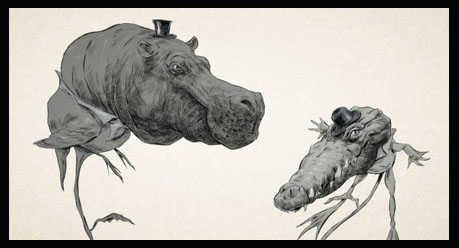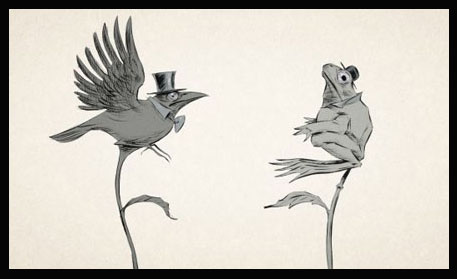
In a year filled with unique shorts vying for the Best Animated Short Film Academy Award, director Claude Cloutier’s Bad Seeds is certainly unforgettable. In this Email Q&A, Cloutier describes what went into making his Oscar shortlisted entry.
Jackson Murphy: How did you come up with the concept?
Claude Cloutier: The concept for Bad Seeds was inspired by La Fontaine’s Fables. The fable is a narrative form that lends itself well to short-form animation because of the length and the metaphorical language. I especially like the principle in fables whereby animals can be used to stand in for people. In my case, every new film is in reaction to the previous one. I had spent a few years drawing cars for Carface, so I felt a need to draw organic shapes.

JM: What were your goals in making the frog and bird plant enemies look good visually?
CC: I always pay special attention to the graphical aspect in my films. For Bad Seeds I wanted to develop a style that mimicked engravings, inspired by 19th-century illustrators like Gustave Doré and John Tenniel (Alice in Wonderland). I chose that style to evoke the classical look that we associate with tales and fables. Also, I found the realism of that drawing style, its high degree of fine detail, very stimulating as an animation challenge.
JM: Was it always your intention to make the faces and heads more detailed as the short goes on?

Claude Cloutier
JM: How did you decide which heads of animals and people to choose?
CC: The film is grounded in the idea of conflict. I had to come up with characters that had relationships based on rivalry: predator/prey for the animals, and personal or political conflicts for the humans. At one point in the film, when the head transformations speed up, the choice of human figures becomes arbitrary and gives way to a kind of improvisation. At that point I chose personalities that I myself admire and others that I simply felt like drawing.
JM: The speed of the head montage is incredible. How did you pull that off, technically?
CC: In a minimalist film where the narrative elements are reduced to their simplest expression—two main characters, one supporting character (the insect), no background for almost the entire running time—editing takes on the utmost importance. So that’s an aspect that Guillaume Fortin and I worked on a lot. There was a lot of trial and error. For the same reasons, the sound design (by Olivier Calvert) was really important, and it was hard to get the balance right in that case as well.
JM: The ending has a lot to say about rivalry, relationships and how sometimes
we’re never quite satisfied. Which themes stand out to you when it comes to the final section of Bad Seeds?
CC: I wanted to make the audience think about human relationships. The characters represent relatives, neighbors, races, nations. . . Relationships between these individuals, or groups, are sometimes hostile and often involve competition for material possessions. My message is that there are plenty of ‘flies’ for everyone!

JM: Bad Seeds is a cool animation exercise, but it also has a really interesting
story. How important is it to have BOTH of these components when making an animated short?
CC: Whenever I approach a new film, the visual aspect comes first. Often the idea comes to me from very free-form graphical explorations, different styles and media, that make up a kind of one-person brainstorming session. At a certain point in my process, there’s an image that ends up being the trigger for my next project. From that moment on, the visual aspect as well as the narrative and philosophical content develop simultaneously, in parallel. They’re always quite bound up together. Some animation films have the potential to reach a huge audience, and I like the idea that I can send a personal message to that audience.
JM: How does it feel to be on the Oscar shortlist, and how would you feel about being an Oscar nominee and attending the ceremony?
CC: The release of Bad Seeds was disrupted by COVID-19. Festivals happened online and it was very hard for filmmakers to assess the impact of their films. Normally, attending a number of screenings with an audience gives you a more specific idea of how your film is being received. For a long time after my film came out, I got zero feedback. Since then, there have been a few festival awards and this Oscar shortlisting, which have been a great comfort. For me, the shortlist is an achievement in itself, and I’m trying not to think too much about what happens next.
- INTERVIEW: “Inside Out 2” Director And Producer On Pixar Sequel - April 16, 2024
- INTERVIEW: “Puffin Rock And The New Friends” And 25 Years Of Cartoon Saloon - April 10, 2024
- INTERVIEW: “Chicken For Linda!” Directors On Annecy Winning Feature - April 9, 2024


 January 21st, 2022
January 21st, 2022  Jackson Murphy
Jackson Murphy  Posted in
Posted in  Tags:
Tags: 






